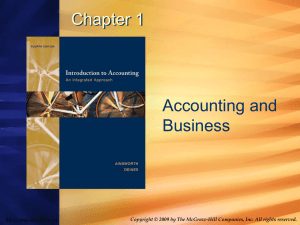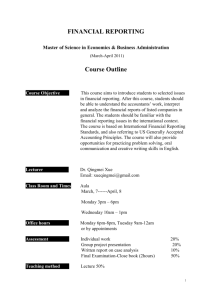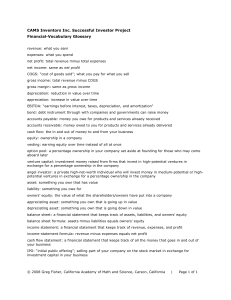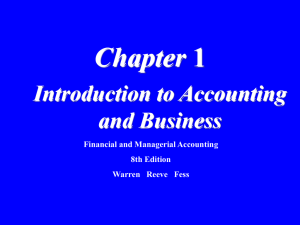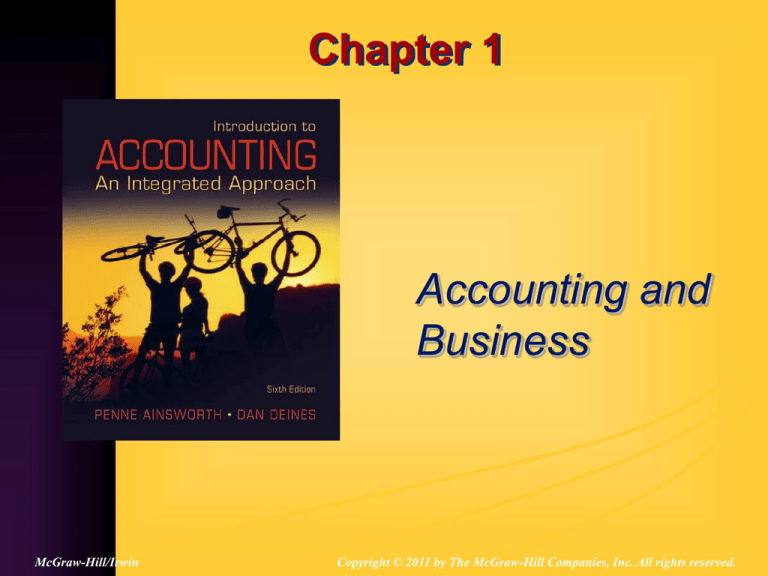
Chapter 1
Accounting and
Business
McGraw-Hill/Irwin
Copyright © 2011 by The McGraw-Hill Companies, Inc. All rights reserved.
What are the Basic Functions of
Business?
• Marketing
Products, pricing, promotion, distribution
• Human resources
Jobs, people, salaries, benefits
• Production and operations
Planning, directing, controlling, evaluating
• Finance
Capital maintenance
• Accounting and information systems
Information infrastructure
1-2
How do the Functions Use
Accounting Information?
• Marketing
Pricing, distribution costs
• Human resources
Pay and fringe benefits, hiring costs
• Production and operations
Production costs—actual and budgeted
• Finance
Cost of borrowing, benefits expected
1-3
How has Business Evolved?
• Sole proprietorship
One owner
• Partnership
Two or more owners
• Corporation
Many owners
1-4
• Merchandising
Buy and sell products
• Service
Provide service
• Manufacturing
Make and sell
products
How has Accounting Evolved?
• Determination of wealth
What am I worth today
• Determination of income
How has my wealth changed
• On-going success
How is the business doing
1-5
What are the Characteristics of
Business Today?
• Customer-focused operations
• Global markets
Products, labor, and capital
• Advanced manufacturing and
communications
• eBusiness
B2B and B2C
• Hybrid organizational structures
1-6
What are the Basic Concepts of
Accounting?
• Business entity
Keep business and personal records separate
• Monetary unit
Maintain business records in currency
• Going concern
Business will continue past the current period
• Periodicity
Profits/losses must be determined periodically
1-7
What are the 5 Basic Elements of
Accounting?
• Asset
Right to use resources with future benefit
• Liability
Obligation to transfer resources in the future
to suppliers of goods and services
• Owners’ equity
Net assets belong to owners
1-8
5 Basic Elements Continued
• Revenues (accrual basis)
Amounts earned from providing goods
and services
• Expenses (accrual basis)
Amounts incurred in an attempt to
generate revenues
1-9
Example
• A company provides $120,000 of services
during the year of which $100,000 were
received in cash. The company’s employees
earned $70,000 in wages, but due to the way
payroll is determined, they were only paid
$55,000 during the period.
• What is the accrual-based income?
• What is the cash-based income?
1-10
Answers
Accrual-based income:
Revenues earned
Less expenses incurred
= Income
$120,000
70,000
$ 50,000
Cash-based income:
Revenues received
Less expenses paid
= Income
1-11
$100,000
55,000
$ 45,000
What is GAAP and the IFRS?
• Generally Accepted Accounting Principles
• International Financial Reporting standards
• Financial Accounting Standards Board
Current rule-making body in U.S.
• International Accounting Standards Board
Current rule-making body internationally
1-12
What are the Concepts
Statements?
• Concepts Statement #1
Useful information for decision making
• Concepts Statement #2
Characteristics of accounting information
• Concepts Statement #3 (superceded)
• Concepts Statement #4
Objectives for nonbusiness organizations
1-13
Concepts Continued
• Concepts Statement #5
Financial statements
• Concepts Statement #6
Elements of financial statements
• Concepts Statement #7
Estimating value of future cash flows
1-14
What Makes Information Useful?
• Relevance
Capable of making a difference
• Reliability
Dependable
• Benefits > Costs
Benefits derived must be greater than
cost
• Materiality
Large enough to have an impact on a
decision
1-15
What are the 4 Basic Financial
Statements and Auditors’ Report?
• Income statement
Indicates revenues less expenses = net
income for a period of time
• Statement of cash flows
Indicates cash inflows and outflows from
operating, investing, and financing activities
for a period of time
• Statement of owners’ equity
Indicates changes in owners’ equity for a
period of time
1-16
Financial Statements Continued
• Balance sheet
Indicates the ending balances of assets,
liabilities, and owners’ equity at a point in
time
• Auditor’s report
Indicates whether the company followed
GAAP when preparing its financial statements
1-17
What are the Purposes of the
Ratios?
• Current ratio
Relationship between current assets and
current liabilities
• Debt to equity ratio
Relationship between liabilities and owners’
equity
• Return on sales
Relationship between net income and sales
1-18
Example
Use the following information to calculate the ratios:
Accounts payable, $136
Accounts receivable, $876
Cash, $2,211
Common stock, $3,827
Cost of goods sold, $8,192 Inventory, $908
Long-term bank loan, $716
Miscellaneous payables, $529
Operating expenses, $5,436
Retained earnings, $373
Sales, $13,353
1-19
Answers
Current ratio = ($876 + $908 + $2,211) /
($136 + $529) = 6.01 to 1
Debt to equity ratio = ($136 + $716 + $529) /
($3,827 + $373) = 0.33 to 1
Return on sales ratio = $275 / $13,353 =
2.06% ($13,353 - $8,192 - $5,436 = $275)
1-20


